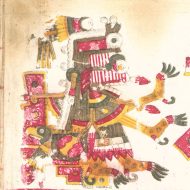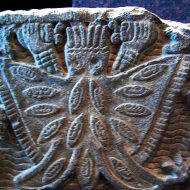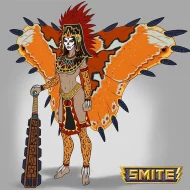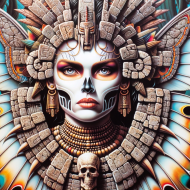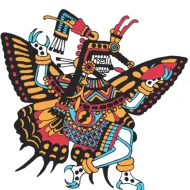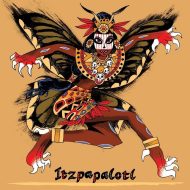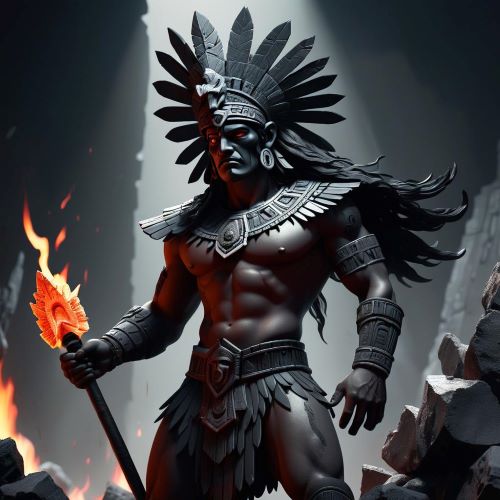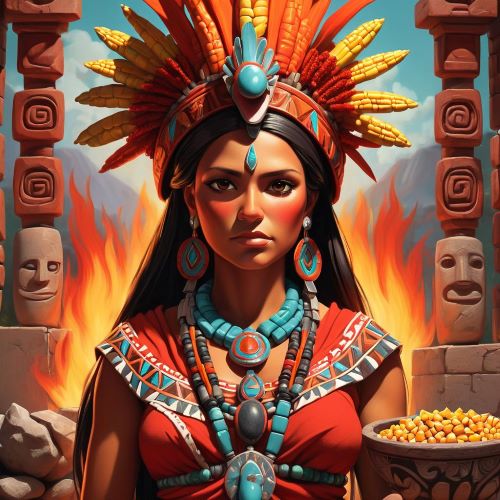Itzpapalotl : The Obsidian Butterfly
Listen
At a glance
| Description | |
|---|---|
| Origin | Aztec Mythology |
| Classification | Gods |
| Family Members | Mixcoatl (Daughter) |
| Region | Mexico |
| Associated With | Magic, Shapeshifting, Butterflies |
Itzpapalotl
Introduction
Itzpapalotl, also recognized as the Obsidian Butterfly, stands as a formidable deity within Aztec mythology. Her dominion extends over realms of death and rebirth, presenting herself as a skeletal entity adorned with jaguar claws and formidable obsidian wings. An integral member of the Tzitzimime, a collective of potent star-demons, she assumes the role of protector for midwives and women undergoing childbirth.
At the helm of Tamoanchan, the celestial sphere where the human race found its genesis, Itzpapalotl holds sway and is venerated as the matron of witches. The goddess exhibits a multifaceted nature, gracefully navigating between the realms of creation and destruction, motherhood and bloodshed. In her dual roles as a benevolent queen presiding over paradise and a formidable warrior, Itzpapalotl manifests her might in diverse and intriguing ways.
Physical Traits
Itzpapalotl is envisioned as a formidable female warrior, her countenance adorned with butterfly wings that resemble stone blades, complemented by a skeletal head and claws. Her wings, akin to obsidian or tecpatl (flint) knives, exhibit a sharpness that evokes a sense of danger. Alternately, depictions may feature her with bat wings, though she is also known to manifest attributes of a clear butterfly or eagle. The physical embodiment of Itzpapalotl encapsulates this duality vividly — picture a skeletal form, bones polished to a gleam like obsidian, draped with the tattered remnants of butterfly wings. Her hands and feet are equipped with razor-sharp talons, serving as an eerie testament to her simultaneous association with both beauty and devastation.
Along the edges of her wings, jagged obsidian blades stand prominently, radiating a lethal allure. Certain representations of Itzpapalotl showcase her wearing a skull mask, with fiery eyes piercing through the darkness, a constant and haunting reminder of the underworld she holds dominion over. The imagery encapsulates the intricate duality present in her character, embodying both the allure of transformation and the foreboding specter of the realm she governs.
Family
Within Aztec religious beliefs, Itzpapalotl assumes the role of Mixcoatl’s mother, holding a prominent position among the Tzitzimime, a formidable group of star-demons steeped in danger in Aztec mythology. Aligning herself with other influential female deities such as Cihuateteo, Tlaltecuhtli, Coatlicue, Citlalicue, and Cihuacoatl, the Tzitzimime collectively act as guardians for midwives and women during labor. In the intricate tapestry of Aztec deities, Itzpapalotl occupies a central and vital role.
Significantly, she is acknowledged as the mother of Mixcoatl, the god associated with both the hunt and sacrifice. This maternal connection serves as a poignant illustration of the Aztec conviction that sacrifice, symbolized by the shedding of blood, contributes to the perpetual cycle of life and death. Itzpapalotl herself actively participates in this cosmic cycle, dwelling in the ethereal paradise of Tamoanchan. Here, she tends to the souls of infants who met an untimely demise before reaching adulthood. A peculiar yet vital aspect of her role involves nurturing these souls by providing sustenance from the mythical “Suckling Tree,” an act that is simultaneously macabre and life-affirming.
Additionally, Itzpapalotl is closely linked to the Cihuateteo, a group of goddesses associated with women who passed away during childbirth. She, in essence, is considered one of them, collectively wielding power that extends to the celestial realm, influencing natural phenomena like earthquakes and storms. This interconnectedness with the forces of nature underscores Itzpapalotl’s role as a potent deity intricately tied to the cycles of life, death, and the delicate balance maintained within the Aztec cosmogony.
Other names
The name Itzpapalotl holds dual meanings, potentially signifying either “obsidian butterfly” or “clawed butterfly.” The latter interpretation appears more plausible, suggesting a connection to the bat. Itzpapalotl is recognized by various names, each shedding light on distinct aspects of her nature and characteristics. Among these alternative names is Cihuateteo, translating to “Divine Women” or “Divine Damsels.” This particular designation underscores her close association with the spirits of women who passed away during childbirth, thereby deepening her role in facilitating the transition between life and death.
Powers and Abilities
Itzpapalotl is renowned as a shamanic goddess and formidable sorceress, possessing the ability to assume various forms. She could appear as a beguiling and alluring woman with long, ebony hair and an impeccably white visage, or she could manifest as a fearsome skeletal butterfly, instilling fear in those who lay eyes upon her. In certain Aztec myths, Itzpapalotl, alongside her Tzitzimimeh companions, adopts the guise of a black butterfly during solar eclipses, using this disguise to consume souls.
The powers wielded by Itzpapalotl are as diverse as her complex personality. Ascending to the position of the queen of Tamoanchan, she commands the heavens, exerting influence over fate and destiny. As a warrior goddess, she leads the Tzitzimime, a cohort of formidable star demons that pose a threat to devouring the sun during eclipses. Itzpapalotl’s capacity to manipulate the celestial realm and instill terror underscores the magnitude of her power.
Beyond her dominion over the heavens, Itzpapalotl possesses remarkable regenerative abilities, mirroring the cyclical essence of life and death that she embodies. Her association with obsidian affords her access to the transformative potential inherent in the material, positioning her as both a creator and a destroyer. This multifaceted nature reinforces Itzpapalotl’s standing as a deity of immense prowess and significance within the intricate tapestry of Aztec mythology.
Modern Day Influence
Itzpapalotl’s impact transcends the confines of ancient mythology, making a notable imprint on modern culture. An illustration of this influence can be found in the character Orizaba the Moth Fairy, a villain in the television series Elena of Avalor, whose conception was inspired by Itzpapalotl. Moving beyond the realm of pop culture, the goddess’s name has been lent to geological formations known as the Itzpapalotl Tessera on the planet Venus. These formations are subjects of scientific inquiry, offering insights into the geological history of both Venus and Earth.
In literature, the enigmatic charm of Itzpapalotl has not been overlooked. Authors and storytellers delve into Aztec mythology, utilizing its rich tapestry to craft narratives that probe the intricacies of human existence, the relentless passage of time, and the delicate dance between life and death. The timeless allure of these ancient myths stands as a testament to their enduring relevance and the lasting impact of figures like Itzpapalotl.
Moreover, elements of Aztec mythology, prominently featuring the imagery associated with Itzpapalotl, frequently emerge in various forms of media within popular culture. Whether in movies, television shows, video games, or graphic novels, the echoes of these ancient myths resonate with audiences across the globe. The seamless fusion of age-old beliefs with contemporary storytelling techniques not only breathes life into the legacy of Itzpapalotl but also ensures its vibrant presence within the collective imagination of modern society.
Related Images
Frequently Asked Questions
What is lorem Ipsum?
I am text block. Click edit button to change this text. Lorem ipsum dolor sit amet, consectetur adipiscing elit. Ut elit tellus, luctus nec ullamcorper mattis, pulvinar dapibus leo.
What is lorem Ipsum?
I am text block. Click edit button to change this text. Lorem ipsum dolor sit amet, consectetur adipiscing elit. Ut elit tellus, luctus nec ullamcorper mattis, pulvinar dapibus leo.
What is lorem Ipsum?
I am text block. Click edit button to change this text. Lorem ipsum dolor sit amet, consectetur adipiscing elit. Ut elit tellus, luctus nec ullamcorper mattis, pulvinar dapibus leo.
What is lorem Ipsum?
I am text block. Click edit button to change this text. Lorem ipsum dolor sit amet, consectetur adipiscing elit. Ut elit tellus, luctus nec ullamcorper mattis, pulvinar dapibus leo.
What is lorem Ipsum?
I am text block. Click edit button to change this text. Lorem ipsum dolor sit amet, consectetur adipiscing elit. Ut elit tellus, luctus nec ullamcorper mattis, pulvinar dapibus leo.

